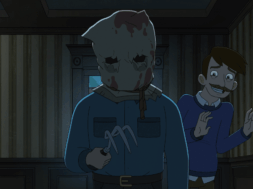The ‘90s often get a bad rap with horror fans. After the numerous successful slashers and creature effects films of the ’80s, the ‘90s offered a different variety of horror fare. Though there were plenty of hits, hidden gems, and misunderstood classics, the ‘90s usually don’t get the kind of love that other decades get when it comes to horror. It’s time to change that.
The Exorcist III never had a chance.
As a follow-up to Exorcist II: The Heretic, it was doomed to be ignored by wide audiences thanks to its predecessor’s abysmal reception. And simply standing in the shadow of The Exorcist would cause it to endure undue criticism by comparison. This is probably one reason why writer/director William Peter Blatty decided to name his sequel novel Legion. And when Blatty was making this third entry, he was under the impression that it would be released under that title. But the studio wanted it to have the Exorcist branding and we got The Exorcist III, a movie that was mostly ignored at the box office and received mixed reviews upon release.
Years later, a cult following started to develop for The Exorcist III. This was partially due to the knowledge that Blatty’s original vision of the film had been subverted by the studio. Extensive reshoots, which included a brand new ending, left fans wondering about the version we never got to see. A few years ago, Scream Factory released The Exorcist III on Blu-ray and included a “Director’s Cut” that did its best to restore Blatty’s intended approach to the movie.
So now, we have two versions of The Exorcist III to enjoy. While the “Director’s Cut” is a fascinating look into a movie that could have been, we’re going to focus on the theatrical cut of The Exorcist III. Why? Because that movie is a masterpiece.
Taking place seventeen years after the events of The Exorcist – and more directly following the canon established in Blatty’s original novel – Lieutenant William Kinderman (George C. Scott) is investigating a series of bizarre and brutal murders that resemble the victims of a serial killer that was executed seventeen years ago. This leads him to a mysterious patient in a psychiatric ward who appears to be Father Damien Karras (Jason Miller), the priest that performed the exorcism on Regan MacNeil and died at the end of The Exorcist. It’s revealed that the Gemini Killer (Brad Dourif) has possessed Karras’s body and is also possessing the elderly catatonics of the psychiatric ward to go out and commit his murders.
There’s a lot more going on in the story but that basic synopsis should give you an idea of how unique The Exorcist III’s plot is compared to both the original film and the majority of possession stories. Blatty found a clever way to continue exploring the world and certain characters from The Exorcist without just doing another riff on what we’d seen before. Creating a detective mystery out of this is an invigorating direction to take.
But it’s not just the story that makes The Exorcist III a triumph. Blatty’s direction is phenomenal at understatement and mood. He eschews the gritty intimacy of Friedkin’s philosophies that we saw in the first film and instead opts for lots of locked-down shots that often linger for longer than we anticipate. So much of The Exorcist III emphasizes the emptiness of space surrounding our characters. Combined with Barry De Vorzon’s droning and non-melodic score, this creates the feeling that evil is a constant force that’s hovering around us at all times. Blatty uses this vacant dread to stunning effect throughout the film, including one jump scare that has become even more recognized than the film itself.
Thankfully, The Exorcist III isn’t just counting on scares and atmosphere. The assembled cast is putting in master level work. George C. Scott’s performance as the world-weary and cynical Kinderman is one of the best in the storied actor’s career. His anger, desperation, and eventual terror at what is happening are played with such conviction that it immediately sells you on the severity of the story. And the scenes between Kinderman and his friend Father Joseph Dyer (Ed Flanders) are so endearing in a way that never feels saccharine or manipulative. These two feel like true old friends. It’s also nice to see Jason Miller return as Father Karras, though Miller’s alcoholism at that point had deteriorated his ability to remember lines. Still, he brings added weight to the entire endeavor and his final moment is a powerful one.
Now, let’s talk about Brad Dourif. He’s horror royalty thanks to his ongoing role as Chucky in the Child’s Play series – he’s especially great in Child’s Play 2 – but his role in The Exorcist III is in contention for his greatest on-screen performance. In the original cut of the film, Dourif was cast as Miller’s replacement for Father Karras. When the reshoots happened, Dourif became the spirit of the Gemini Killer that’s possessing Karras. This means he’s in less of the finished version but it makes his presence even more imposing. Dourif has said that he prefers the original cut and it’s not hard to see why. However, his performance is scarier and more powerful in the theatrical cut. It’s one of the great horror villain characters and it’s a shame the Gemini Killer isn’t seen as such.
Thirty years later, The Exorcist III has finally been getting the accolades it deserves but it’s time to go a step further. The Exorcist III isn’t just a good ‘90s horror movie or a good sequel. The Exorcist III should be as revered as The Exorcist. It’s THAT good. It’s astonishingly creepy, well-constructed, superbly acted, and stands on its own merits to the point that you could watch it without having seen the first film. That’s an impressive feat for any sequel.
Part of the reason for doing this column is to negate the belief and criticism that the ‘90s didn’t bring many horror masterpieces to the table. Without a doubt, The Exorcist III is a horror masterpiece that should be touted as one of the finest examples of horror cinema.












